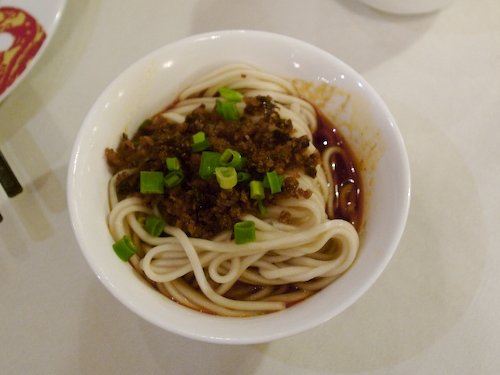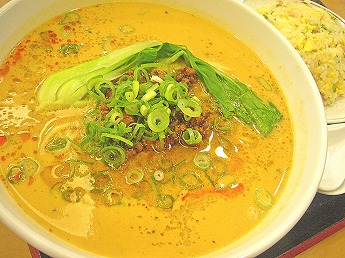My passing remark about how I intend to do a comparison tasting of a lot of different bowls of tantanmen in Kyoto has already prompted some slavering comments, so let’s get cracking.
Before the tasting begins, though, let’s consider what tantan men actually is.
Origins: Dan Dan Mian
This is a Sichuan dish that is, at base, extremely simple. Take hot, fresh egg noodles. Toss with lots of chopped scallion, chili sauce (doubanjiang, for example), soy sauce, chili oil (la-yu), sesame paste, and usually some ground-up Sichuan peppercorns. Often some pickled vegetables are added. Carry it to work in a lunchbox, where the residual heat will bring out the flavors.
Made this way, the dish is a marvelous demonstration of the Sichuan penchant for simple, rustic, yet deep and complex dishes. Every major flavor is here: sweet (sesame paste), sour (in the sauce), salty (soy), bitter (raw scallion). In addition, you have two contested flavors: spicy (chilies) and fatty (sesame and oil). Depending on how the ingredients are prepared, there may also be more or less umami or savory, the famous “fifth flavor.”
And yet, there is nothing additional, no gilding, no tricks. The dish is at base as subtle as an axe. But made well, it’s a dish fit for a peasant or a king.
You will often see it said that there must be ground or minced pork in the dish, and while this is now usual, it is certainly a deviation from its peasant origins. After all, meat of any kind was long a rarity for Chinese peasants, and everything else about the dish bespeaks peasant simplicity. For the same reason, it is very unlikely that the dish would be served in soup, soup being again a delicacy requiring expensive ingredients, time, and cooking fuel.
Japanese Adaptation: Tan Tan Men
I have seen it suggested that tantan men was invented by the “father of Sichuan cuisine” in Japan, Chen Kenichi, who later turned up as Iron Chef Chinese on the original Japanese Iron Chef show. In this account, Chen took a sort of vaguely gourmet version of dandanmian — with the pork, for instance — and made it into ramen-like soup noodles.
Whether this story is actually true or not, certainly the Japanese version is precisely thus. Instead of a sauce, there is a soup consisting of a pork broth (or sometimes chicken, or both) flavored with sesame paste, chili sauce, soy, and chili oil (rayu). Noodles are added, and then topped with minced pork, chopped scallions, sesame seeds, and some kind of vegetable — usually bok choy (chingensai), usually not pickled. In some cases, black sesame (paste and seeds) may be used in place of the usual white. More chili oil is commonly added as a pretty red garnish.
Now I like both the Sichuan version and the Japanese one, and a number of the many variations on the theme that I’ve tried. So, as noted in an earlier post, I have decided that it is my bounden duty to try a ridiculous number of different restaurants’ offerings of tantan men and tell you what I think of them, ultimately leading to a sort of guide.
To my mind, this makes more sense than a guide to ramen in Kyoto. I mean, ramen is all very well, but first of all, which style of ramen? And second, ramen is much too Japanese for me, and never nearly spicy or complicated enough. It’s fine, I guess, but my palate lies much closer to Sichuan and Hunan.
Before finally getting on to specific examples, let’s run through the four basics:
Stock — normally pork or pork-and-chicken. You should be able to tell.
Flavor Base — sesame, chili sauce, soy, and usually chili oil
Noodles — bouncy egg noodles, as in ramen
Topping — minced pork cooked with garlic, ginger, and Sichuan peppercorns until caramelized; green vegetable, pickled or otherwise, usually bok choy; chopped scallion; often sesame seeds; sometimes toasted whole dry chilies and/or toasted Sichuan peppercorns; often a drizzle of chili oil
Each of these basic four components should stand up for itself and be worth eating.
So without further ado....
Ginza Shisen (銀座四川)
In the Porta underground shopping arcade, by Kyoto Station. Here is a Japanese website with links and some reviews and such, giving it an overall 5 out of 5: high marks indeed!
Just goes to show you what trust you can put in websites like that. All told, a pretty mediocre bowl, but so typical that I’ll use it as a first basic discussion.
Stock: Weak, thin, and lacking character. I’d guess it was pork stock, but it tasted mostly of salt. No depth of flavor to stand up to the other ingredients.
Flavor Base: Somebody tell these guys about chili sauce (doubanjiang), because apparently they forgot it. Thus the flavoring was sweet and rich, and rather salty, but lacked both the fire and the complex sourness of chili sauce. As a result it seemed, again, thin and lacking character.
Noodles: Respectable ramen noodles, but a little too eggy for my taste. This would have been perfect for the dish, actually, if the other things had stood up to it — if your noodles are too light they ought to be overpowered.
Toppings: Minced pork appeared to be simply stir-fried without any significant flavoring, and certainly wasn’t caramelized; bok choy was respectable; minimal scallion; no sesame seeds; and finally a couple drops of chili oil off to the side as a sort of ironic comment on the lack of flavor here. No hint of Sichuan peppercorns anywhere.
The thing is, I’d currently give this about a 4 out of 10. From what I’ve said, it sounds like I’d give it a right panning, but in fact, it was well within the average range of tantan men as I’ve had it in Kyoto. Weak, thin, low on flavor, poorly balanced, and basically lacking depth or force... but that’s the way most Japanese seem to like it. Sichuan peppercorns are rare indeed, which means that the dish usually lacks the numbing-spicy special flavor that is distinctive to Sichuan.
Which, in fact, is precisely why I’m doing this little quest. I want to find tantan men made the way I think it should be, not the way they do. I mean, of all people to get Sichuan food wrong, I’d put the Japanese and the English at the top of the list: they don’t like hot spices, garlic, or robust and even brutal flavors. (Let’s not talk about what they call “curry,” okay? The really spicy-hot curries are worse, actually, because they’re just hot with no depth.)
To conclude, I noticed on the way out that more or less next to Ginza Shisen is another place that serves tantanmen, so pretty soon it’s back to Porta for another bowl.
As time goes by (sing with me!), I will post more reviews, and I will also progressively refine my own secret recipe. Ultimately I hope to develop a recipe that is as good as any in Kyoto. And if I can’t, I hope it’s because I’ve found some truly killer tantanmen.




No comments:
Post a Comment